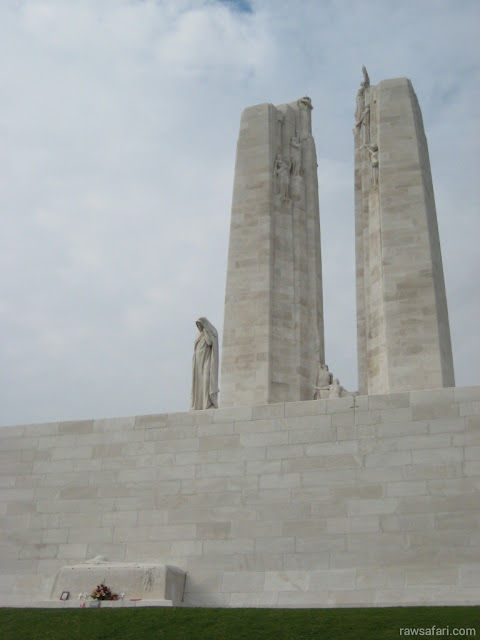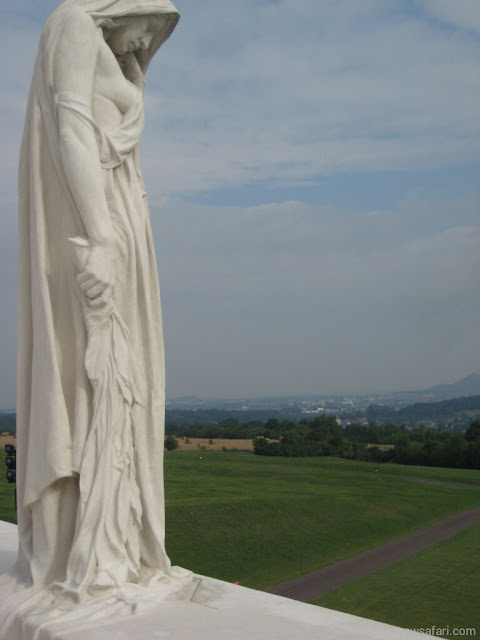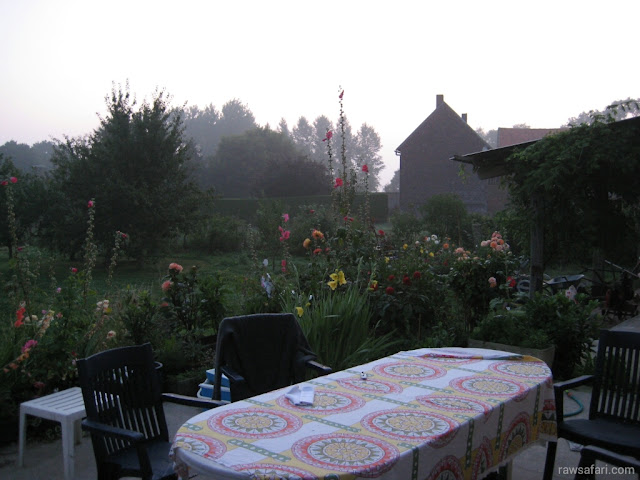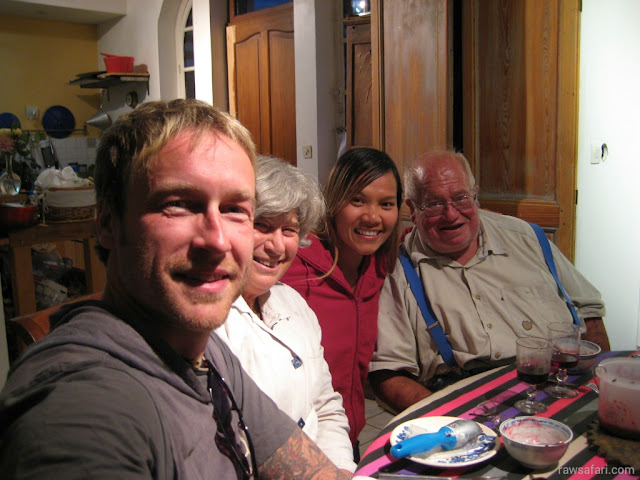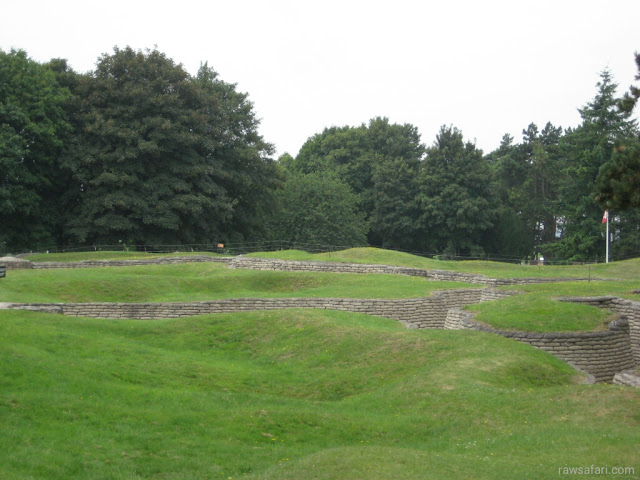Riding with Belgians and Dutch, as we head south, we hear the same thing time and time again:
“you will not be able to get rides in France; the French are a rude arrogant lot; they don’t speak to you if you can’t speak French; they don’t like foreigners…”
We start to wonder if we will ever get from one side of France to the other. But then the Dutch told us we would come to a grinding halt when we reached the Belgian border, so we aren’t giving up hope yet.
(Top: Normandy is full of holes and skeletons.)
Our entry point to the land of fromage and escargot is Normandy. Our ride is a Belgian history buff, on a two day tour of WW1 battle memorials and cemeteries.
“Hello,” he says cheerfully, as we climb into his van. “Where are you going?”
“To France” we reply, gamely.
He makes a face.
“France? Hitchhiking? Impossible. The French do not pick up hitchhikers. Actually you will probably be arrested. If you are interested though, I am going to go to a few places to see the historical sites. You are welcome to come if you wish.”
Normandy is peppered with holes. Mortar craters, trenches, graves, and in a few places huge pits, 20 meters deep, where allied tunnelers set explosive charges under German command posts and blew them up. Many of the battle fields are marked by monuments, some of them extremely beautiful and emotionally touching. Every town seems to have at least three war cemeteries. The length of the casualty lists alone is overwhelming. At the very large British monument, the name “Marshall”, my own family name, jumps out at me from every other wall.
The Canadian monument to their fallen at Vimy Ridge is soaringly beautiful and very moving. The symbolism is narrative, and clear. As we approach the ridge from the northern side, we see the reclining figures of a man and a woman, in superb physical health, and complete tranquility. At the central pass between the two obelisks, the man and the woman climb steps together, he holding aloft a flaming torch, reminiscent of that borne by the statue of liberty, she gazing intently toward the battle field below. On the lowest rampart of the monuments southern side, the figure of the woman stands on top of the wall, seeming to be growing from the stone. Head downcast, draped in a shawl, she stands, significantly alone. This is a monument to sacrifice, not glory. All around, the green lawn writhes and undulates over countless craters, trenches, and ruins, and I am powerfully aware that only a very small proportion of the men who died here were ever found and identified; most of their bodies are still embedded in Vimy Ridge.
We leave our Belgian guides at a tiny village called Beumont. We are world war weary. After a quick recce of the town we realise that maybe we didn’t pick the best place to try and pick up a ride though. The whole village is 12 houses two tractors and a bored looking pony. We stand beside the road for an hour and the only vehicle to go past is a curious looking young man on a bicycle. We know our belgian friends have gone on to another monument a mile outside the town, so we start walking, hoping to catch them up before they head for Ypres or Omaha Beach.
Striding down the road, the only traffic is us. We are starting to think we could be spending a long time in Beumont, and it crosses our minds for a moment to borrow the bored pony. A car approaches and we dance and wave our thumbs around like a couple of chimps at feeding time. The driver pulls up and we climb in gratefully.
Francois is a portly man in late middle age with a red nose, twinkling eyes, and a slow, deliberate way of speaking. He looks part santa claus, part Yoda, and all French.
“Young Australians, I have for you, a proposition” he drawls. “I must go to the town of Albert, on the road not far, and there go to a shop for half an hour. I will take you to a restaurant, you will have some lunch, and I will pay for whatever you want to eat, why not? After that, you may come to my home, have some wine and have a hot shower.”
“Tres bon!” we cry in unison, “Merci!”
We ride into town, and Francois pulls up outside the restaurant.
“I will meet you here in 30 minutes” he says. “You can leave your bags in the car, it is not a problem.”
We take our bags with us though, of course, being hardened travellers. I fear we have offended Francois.
We see that the restaurant is expensive. If Francois comes back, we feel bad to run up a large bill for him at the restaurant, and if he does not we do not want to pay for an expensive meal ourselves so we hustle up the road to the supermarket for some bread and cheese.Walking along the street it is clear that Australians are popular people here. Several people see the flags on our backpacks and greet us warmly in English. The role Australians played in liberating France in the world wars has not been forgotten here in Normandy. In fact it would be hard to forget when there are cemeteries all over the region containing the remains of Aussies who died defending France’s sovereignty.
Half an hour later, we are back outside the swanky resaurant eating our bread and cheese. Right on time, Francois pulls up. He seems slightly disappointed to see us eating supermarket cheese, but invites us back into his car anyway.We ride to Francois’ home a few minutes away. It is in a tiny village named Colincamps. Francois’ house is elderly, comfortable and stuffed with antiques, art, and curiosities from all over the planet. These include african wood carvings, regency furniture, a medieval closet, and his mother in law, a frail woman with a defective hearing aid, who claims to dislike Normandy intensely, and prefers the south of France where she was born.
“She is 94 years old” Francois informs us.
“I am 92!” retorts his mother in law in an offended tone.
Francois serves us a delicious cocktail of white wine and grapefruit juice, which he claims is France’s national drink, accompanied by crisp bread, and a camembert which tastes as if it has died and gone to heaven.
“We must eat it all, because tomorrow it is no good” he advises us.
We comply happily. Francois’ mother in law sings a bawdy song to herself. Nia requests a translation of the lyrics. Francois’ mother in law tuts at our lack of French, but obligingly informs us that it is a traditional drinking song, which goes: “we go out and have a good time, until the stupid women show up and spoil our night…”
Caterine, Francois’ wife comes home and we have more drinks. Caterine is a keen art student at an adult education college, and a furniture restorer, which explains all the beautiful antiques. She proudly shows us her watercolours, which are very pretty.
Francois takes us to his cellar. Stone walls and a sand floor to keep his wine bottles cool and dry. he selects 3 wines and we settle down at the kitchen counter to taste them. The first one we taste is delicious, and quite potent, and every bit as good as Australian wine, I must admit. The second one is husky, strong, and fruity. We comment to Francois that we like it and he smiles. We taste the third wine and I realise that I have never drunk good wine before. The flavours are rich, complicated and savoury. I distinctly taste rosemary, bread, beef and fruit. This wine mirrors and compliments the potent flavours of the camembert, and I feel as if I am drinking a meal. Francois casually remarks that this wine is worth two hundred Euro a bottle, but he has good connections in the local vineyards, so he takes his own bottles and fills them for ten Euro each.
Francois tells us about his work as a refugee advocate, and Caterine enthuses about antiques, Kafka, fine art, history, and food. We eat the best goat cheese we have ever tasted, and lamb chops for dinner.
“This lamb may be Australian, or British, we are not sure” Caterine tells us.
“Its delicious” I say, “it must be Aussie!”.
(…our wine and cheese are crap, but our lamb is good, I reassure myself.)
After we eat Francois opens another bottle, and discusses the history of Normandy with us.
Francois tells us that local farmers in Le Somme still occasionaly find skeletons when they are tilling their fields.
“If they are clearly identifiable by the uniforms as German or British, no problem, the foreign embassies will come and collect them. But if they are French, or have no identification, oohlala! A headache! They must contact the War Ministry, the mayor, the chief of police. It may be weeks before they can continue to sow their crop. Sometimes the sheep find unexploded bombs. A lot of minced lamb…”
The legacy of the World Wars is an ever present part of Normandy’s culture and landscape. There are annual events to commemorate the people who gave their lives for liberty, for god, and for the vanity of powerful men.
Every year to commemorate the British dead, there is a name reading ceremony at the Somme Memorial Francois tells us. Every name on the monument is read aloud. It takes nearly twenty four hours.
The sun sets spectacularly behind Francois’ fruit trees, and a light breeze sways the flowers in the abundantly overgrown back garden.
We drain our glasses, and Francois refills them. He sits back and watches the sunset with moist eyes.
“A huge insanity” he says softly. “That is warfare. A madness of enormous proportion.”
Half a bottle of fine red later, I lie on Francois’ couch bed, content with wine and good food. French and Australians really have a lot in common it seems; passionate about liberty, democracy and grog.
Francois’ hospitality has been the most perfect way to be introduced to France, and I know I will never believe anyone who bad-mouths the French again.
(The Canadian monument at Vimy Ridge)
(Francois, our gracious host)
(Francois’ and Caterine’s beautiful back yard)
(Me, Caterine, Nia and Francois)
(Preserved trench systems in the Somme, Normandy)


